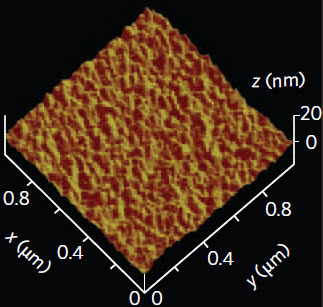Single nanomaterial yields multiple laser colors
May 1, 2012

CQD film surface analyzed by atomic force microscopy (credit: C. Dang, et al./Nature Nanotechnology)
Engineers at Brown University and QD Vision Inc. have created nanoscale single crystals that can produce the red, green, or blue laser light needed in digital displays.
The size determines color, but all the pyramid-shaped quantum dots are made the same way of the same elements. In experiments, light amplification required much less power than previous attempts at the technology. The team’s prototypes are the first lasers of their kind.
Red, green, and blue lasers have become small and cheap enough to find their way into products ranging from BluRay DVD players to fancy pens, but each color is made with different semiconductor materials and by elaborate crystal growth processes.
A new prototype technology demonstrates all three of those colors coming from one material. That could open the door to making high-performance digital displays and other products that use a variety of laser colors all at once.
“Today in order to create a laser display with arbitrary colors, from white to shades of pink or teal, you’d need these three separate material systems to come together in the form of three distinct lasers that would not have anything in common,” said Arto Nurmikko, professor of engineering at Brown University.
The materials in prototype lasers described in the paper are nanometer-sized semiconductor particles called colloidal quantum dots or nanocrystals, with an inner core of cadmium and selenium alloy and a coating of zinc, cadmium, and sulfur alloy and a proprietary organic molecular glue.
Chemists at QD Vision of Lexington, Mass., synthesize the nanocrystals using a wet chemistry process that allows them to precisely vary the nanocrystal size by varying the production time. Size is all that needs to change to produce different laser light colors: 4.2 nanometer cores produce red light, 3.2 nanometer ones emit green light and 2.5 nanometer ones shine blue. Different sizes would produce other colors along the spectrum.
Because of their improved quantum mechanical and electrical performance, the coated pyramids require 10 times less pulsed energy or 1,000 times less power to produce laser light than previous attempts at the technology.
Ref.: Cuong Dang, et al., Red, green and blue lasing enabled by single-exciton gain in colloidal quantum dot films, Nature Nanotechnology, 2012; DOI:10.1038/nnano.2012.61